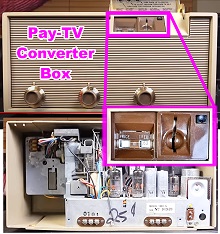Looking Ahead: Pay TV
|
|
Looking Ahead: - and Pay TV Vintage Pay-TV set top converter box. Ten years ago it would have made big waves. But when the FCC ended 15 years of deliberation by finally approving a nationwide system of pay TV, it created scarcely a ripple. Perhaps this was because every experimental pay-TV system so far has thrown in the sponge - the latest being the Zenith-RKO project in Hartford, Conn., which died Jan. 31, 1968. Perhaps, too, it is because of the careful restrictions the commission placed on the see-for-a-fee operations it will permit. These circumscriptions, designed to protect conventional free TV, include: 1. The limiting of pay-TV operations to areas served by five or more stations, and then limiting pay operations to only one station in each area. Under these conditions, there would be a maximum of only 89 areas in the United States which could qualify for pay-TV stations. 2. Movies shown on pay TV, with a few exceptions, must be less than 2 years old. 3. Live sports events of the type shown on free TV within the preceding 2 years may not be shown - with the exception of events normally blacked out in a particular area, such as professional football games in the home team's area. 4. Series programs with regular casts are barred. 5. No commercials may be shown during pay programs. 6. Pay-TV stations must also offer free programs at least 28 hours weekly. 7. At least 10 percent of a station's annual pay-TV programing must be devoted to material other than movies and sports. The FCC withheld judgment on whether it would permit pay TV via cable, but asked the public's views on the subject, in preparation for a future determination. The Zenith-RKO experimental pay system in Hartford, meanwhile, was shut down after 6 1/2 years - for several reasons, including the necessity of developing pay-TV decoders which will work with color programing. The station has now reverted to its regular free commercial TV operation. R-E
Posted April 25, 2023 |
|

 In the February 1967 issue of Radio-Electronics
magazine, editor Forrest Belt wrote about the up-and-coming
In the February 1967 issue of Radio-Electronics
magazine, editor Forrest Belt wrote about the up-and-coming